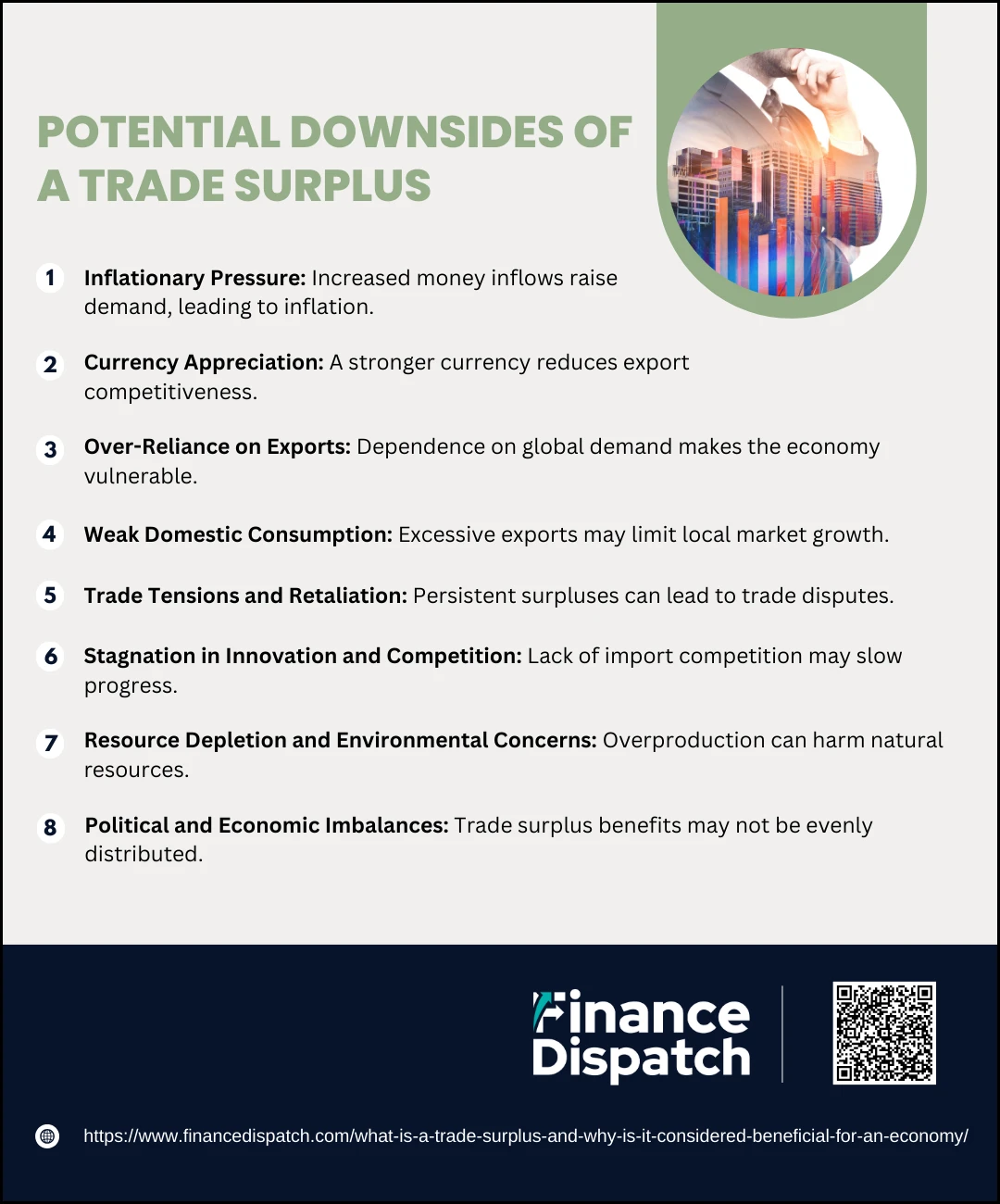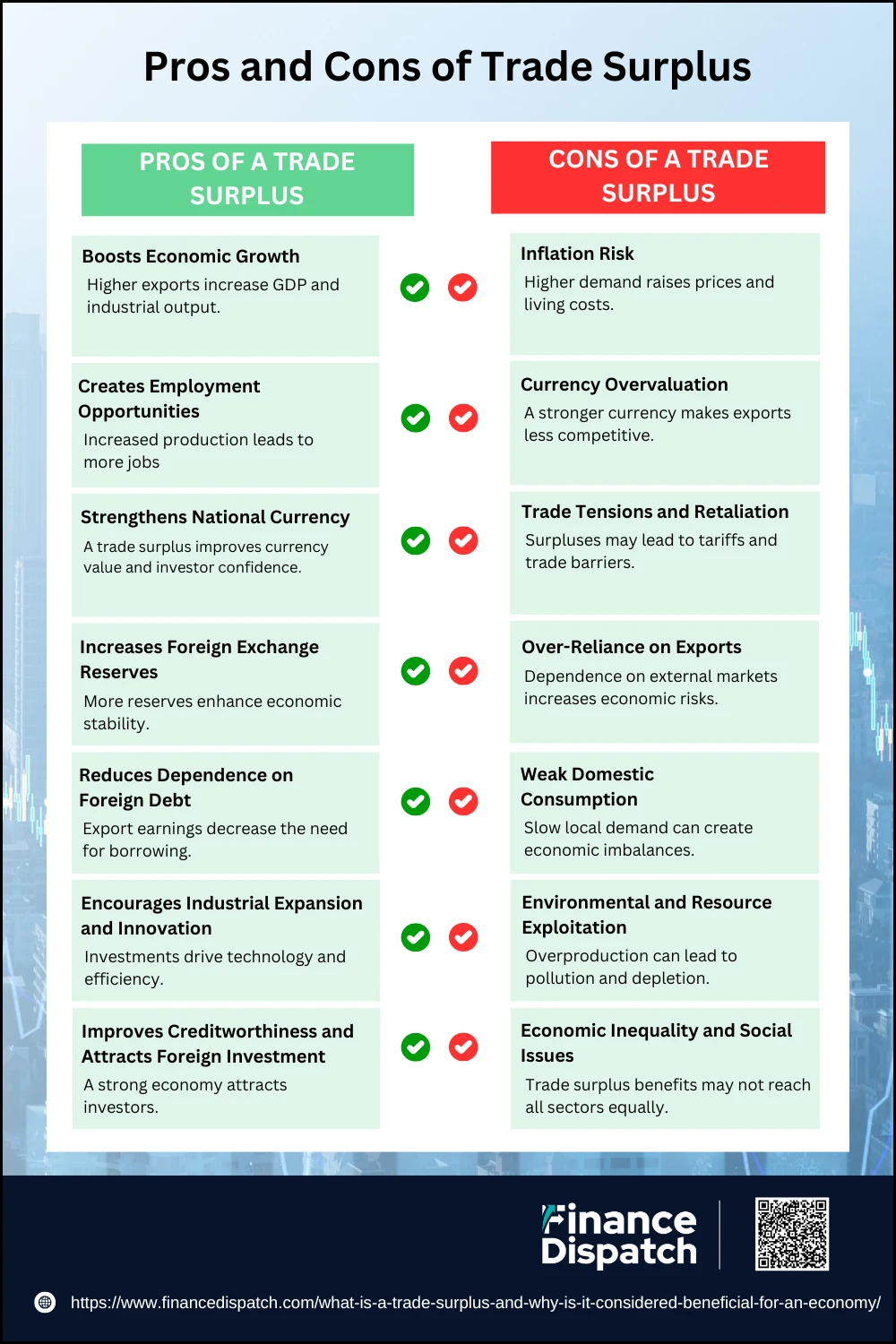A trade surplus occurs when a country exports more goods and services than it imports, creating a positive balance of trade. It is often viewed as a sign of economic strength, as it indicates that a nation is producing valuable goods that are in high demand globally. A trade surplus can lead to increased industrial output, job creation, and economic expansion, ultimately boosting a country’s gross domestic product (GDP). Additionally, it strengthens the national currency and enhances foreign exchange reserves, providing financial stability. However, while trade surpluses offer numerous advantages, they must be managed carefully to avoid economic imbalances. This article explores the concept of trade surplus, its calculation, and why it is generally considered beneficial for an economy.
What is Trade Surplus?
A trade surplus occurs when a country’s total exports exceed its total imports over a specific period, resulting in a positive trade balance. This means that the nation is selling more goods and services to foreign markets than it is purchasing from them. A trade surplus reflects strong domestic production and global demand for a country’s products, contributing to economic growth and job creation. It also leads to a net inflow of foreign currency, strengthening the national economy and increasing foreign exchange reserves. While a trade surplus is generally seen as a sign of economic strength, its long-term effects depend on factors such as exchange rates, trade policies, and global market conditions.
 Why is a Trade Surplus Considered Beneficial?
Why is a Trade Surplus Considered Beneficial?
A trade surplus is often viewed as a positive economic indicator because it signifies that a country is producing and exporting more than it imports. This leads to increased revenue, industrial expansion, and job creation, strengthening the overall economy. While a trade surplus can provide financial stability and economic growth, it must be managed effectively to prevent inflation and trade imbalances. Here are some key reasons why a trade surplus is beneficial:
1. Boosts Economic Growth
A trade surplus contributes to overall economic expansion by increasing a nation’s GDP. Higher export earnings lead to more investments in infrastructure, industry, and technology, accelerating economic development.
2. Creates More Jobs
When exports increase, domestic industries experience higher production demand, leading to job creation in sectors such as manufacturing, agriculture, and technology. More employment opportunities help improve the standard of living for citizens and reduce unemployment rates.
3. Strengthens National Currency
A country with a trade surplus often sees an appreciation in its currency. A strong currency increases purchasing power, lowers the cost of imports, and enhances economic stability by making domestic investments more attractive.
4. Increases Foreign Exchange Reserves
A positive trade balance brings in more foreign currency, which helps a country build substantial reserves. These reserves can be used to stabilize the economy, manage inflation, and protect against financial crises.
5. Reduces Dependence on Foreign Debt
With more export revenues, a country can finance its own economic activities without borrowing from foreign lenders. This reduces external debt burdens and strengthens financial independence.
6. Enhances Industrial and Manufacturing Growth
A trade surplus encourages domestic industries to expand production, invest in new technologies, and improve product quality. This makes a country more competitive in international markets and fosters long-term economic sustainability.
7. Improves Creditworthiness and Investor Confidence
Countries with a strong trade surplus are perceived as economically stable and creditworthy, attracting more foreign investment. This can lead to better financial conditions, lower borrowing costs, and increased business opportunities.
8. Promotes Economic Self-Sufficiency
By exporting more than it imports, a country becomes less reliant on foreign goods and services, allowing it to strengthen domestic industries and achieve long-term economic stability.
9. Reduces Trade Deficit-Related Risks
A country with a trade surplus avoids the financial risks associated with trade deficits, such as currency depreciation, inflation, and economic slowdowns. A strong trade balance ensures more economic control and resilience against external shocks.
10. Encourages Innovation and Competitiveness
To maintain an export advantage, industries in a surplus economy invest in research, development, and efficiency improvements. This leads to technological advancements, better product quality, and enhanced global competitiveness.
Trade Surplus vs. Trade Deficit
A country’s trade balance is determined by the difference between its exports and imports. A trade surplus occurs when a country exports more than it imports, leading to economic growth, higher employment, and increased foreign reserves. In contrast, a trade deficit happens when a country imports more than it exports, which can lead to increased foreign debt, currency depreciation, and economic instability. While both trade surplus and trade deficit have their advantages and disadvantages, their overall impact depends on how well a country manages its trade policies and economic strategies. Below is a comparative table highlighting the key differences between a trade surplus and a trade deficit:
Comparison Table: Trade Surplus vs. Trade Deficit
| Factor | Trade Surplus | Trade Deficit |
| Definition | When a country exports more than it imports. | When a country imports more than it exports. |
| Impact on Economy | Encourages economic growth and industrial expansion. | Can lead to financial instability and increased debt. |
| Effect on Employment | Creates jobs by boosting domestic production. | May lead to job losses due to reliance on imported goods. |
| Currency Strength | Strengthens the national currency due to high demand for exports. | Weakens the national currency as more money flows out for imports. |
| Foreign Exchange Reserves | Increases reserves, enhancing financial stability. | Depletes reserves, making the economy vulnerable to external shocks. |
| Dependence on Foreign Debt | Reduces reliance on foreign borrowing. | Increases reliance on external borrowing to cover trade imbalance. |
| Impact on Inflation | Can cause inflation if demand for domestic goods increases too much. | May reduce inflation as imports provide cheaper alternatives. |
| Trade Relationships | Strengthens economic ties with importing countries. | May lead to trade imbalances and strained relations with surplus nations. |
| Long-term Sustainability | Sustainable if managed well and balanced with domestic consumption. | Unsustainable if imports continuously exceed exports, leading to financial crises. |
Real-World Examples of Trade Surplus Economies
A trade surplus occurs when a country exports more than it imports, creating a positive trade balance. Nations with a consistent trade surplus often have strong industrial bases, high global demand for their products, and competitive exports. These surpluses help strengthen their economies by increasing foreign reserves, boosting employment, and enhancing industrial growth. Below are some key examples of trade surplus economies:
Examples of Trade Surplus Economies
- China – Largest global exporter, mainly in electronics and machinery.
- Germany – Strong in automobile, pharmaceutical, and machinery exports.
- Japan – Known for high-tech industries, including cars and robotics.
- South Korea – Major player in electronics and automotive exports.
- Switzerland – Surplus from pharmaceuticals, financial services, and luxury goods.
- Saudi Arabia – Oil exports drive its trade surplus.
- Norway – Trade surplus fueled by oil, gas, and seafood exports.
- Netherlands – Strong agricultural, chemical, and electronic exports.
 Potential Downsides of a Trade Surplus
Potential Downsides of a Trade Surplus
A trade surplus is often seen as a positive economic indicator, as it signifies strong exports, increased employment, and financial stability. However, an excessive or prolonged trade surplus can lead to significant economic and political challenges. Relying too much on exports can make a country vulnerable to fluctuations in global demand, reduce domestic consumption, and cause trade imbalances with other nations. Additionally, a trade surplus can create inflationary pressures, affect currency value, and even lead to trade disputes. Below are some key downsides of maintaining a large trade surplus over time:
1. Inflationary Pressure
A trade surplus increases money inflows, which can lead to excessive demand for goods and services. As domestic demand rises, prices increase, leading to inflation. Inflation reduces purchasing power and can make living costs more expensive for citizens.
2. Currency Appreciation
A consistent trade surplus increases demand for the country’s currency, causing it to appreciate in value. A stronger currency makes exports more expensive for foreign buyers, reducing export competitiveness. This may lead to a decline in future exports, ultimately reducing the benefits of the surplus.
3. Over-Reliance on Exports
Countries with large trade surpluses often depend heavily on foreign markets to sustain economic growth. If global demand weakens or a major trading partner imposes restrictions, the economy may suffer. This lack of diversification makes the country vulnerable to external shocks and recessions.
4. Weak Domestic Consumption
A trade surplus often means that a country is producing more than it consumes. Low domestic demand can indicate economic inequality, where industries focus on exports rather than fulfilling local needs. Without a strong consumer market, economic growth may become unsustainable in the long run.
5. Trade Tensions and Retaliation
Countries with persistent trade surpluses may face political and economic backlash from trade partners. Deficit countries may accuse surplus economies of engaging in unfair trade practices, leading to tariffs, trade restrictions, and sanctions. Trade conflicts can disrupt global supply chains and negatively impact businesses that rely on international trade.
6. Stagnation in Innovation and Competition
If a country’s industries are too focused on existing successful exports, they may neglect innovation and diversification. Lack of import competition can reduce incentives for businesses to improve efficiency and technology. Over time, industries may become less adaptable, making it harder for the economy to respond to changing global trends.
7. Resource Depletion and Environmental Concerns
Some countries achieve trade surpluses by overexploiting natural resources, such as oil, minerals, or agricultural products. High industrial production can lead to deforestation, pollution, and environmental degradation. Without sustainable resource management, long-term economic stability can be threatened.
8. Political and Economic Imbalances
A large trade surplus can create economic inequalities within the country, benefiting large export industries but neglecting small businesses and consumers. Concentration of wealth in export-driven industries may lead to social unrest and economic disparities. Governments may prioritize export-focused policies while ignoring other key sectors like healthcare, education, and infrastructure.
 Pros and Cons of Trade Surplus
Pros and Cons of Trade Surplus
A trade surplus occurs when a country exports more than it imports, leading to a positive trade balance. It is often seen as a sign of economic strength, as it indicates high global demand for a country’s goods and services. A trade surplus can boost economic growth, increase employment, and strengthen a country’s financial stability. However, if not managed properly, it can also lead to inflation, currency overvaluation, and trade tensions with other nations. Below are the key pros and cons of maintaining a trade surplus.
Pros of a Trade Surplus
1. Boosts Economic Growth
A trade surplus contributes directly to a country’s gross domestic product (GDP) by increasing revenue from exports. As businesses expand production to meet international demand, it leads to higher industrial output and economic progress.
2. Creates Employment Opportunities
More exports mean higher demand for workers in industries such as manufacturing, agriculture, and technology. This helps reduce unemployment rates and improves wages and living standards for workers.
3. Strengthens National Currency
A high trade surplus leads to a stronger national currency because foreign buyers need to exchange their currency for the exporter’s currency. A stronger currency improves global investor confidence and can reduce import costs for essential goods.
4. Increases Foreign Exchange Reserves
Export earnings contribute to a large reserve of foreign currency, which strengthens economic security. Countries with high foreign exchange reserves can stabilize their economies during downturns or financial crises.
5. Reduces Dependence on Foreign Debt
Higher export revenues mean a country can finance its own development projects without borrowing from foreign lenders. This reduces national debt burdens and enhances financial independence.
6. Encourages Industrial Expansion and Innovation
Countries with a strong trade surplus invest in technology, research, and development to maintain their global competitive edge. This drives innovation, improves product quality, and strengthens domestic industries.
7. Improves Creditworthiness and Attracts Foreign Investment
A country with a stable trade surplus is considered financially secure and attracts more foreign direct investment (FDI). Foreign investors are more likely to invest in industries when a country’s economy is stable and growing.
Cons of a Trade Surplus
1. Inflation Risk
A prolonged trade surplus increases demand for domestic goods, leading to higher prices and inflation. Inflation can reduce consumer purchasing power and lead to higher costs of living.
2. Currency Overvaluation
A consistent trade surplus increases the value of a country’s currency in foreign exchange markets. A stronger currency makes exports more expensive, reducing international demand and making exports less competitive over time.
3. Trade Tensions and Retaliation
Countries with persistent trade surpluses may be accused of engaging in unfair trade practices or currency manipulation. Other countries may impose tariffs or trade barriers, leading to trade disputes that disrupt global trade relations.
4. Over-Reliance on Exports
A country that depends too much on exports may become vulnerable to external economic downturns. If global demand declines, industries may suffer from slow growth, layoffs, and economic instability.
5. Weak Domestic Consumption
A trade surplus often means that domestic demand is low, which can indicate slow wage growth or weak consumer spending. An economy that relies too much on exports may neglect internal markets, leading to economic imbalances.
6. Environmental and Resource Exploitation
High production levels to meet export demand can lead to overuse of natural resources such as oil, minerals, and forests. Increased industrial output can cause pollution and environmental degradation if not properly regulated.
7. Economic Inequality and Social Issues
A trade surplus often benefits large industries and multinational companies, while smaller businesses and consumers may not experience the same financial gains. If government policies favor exporters too much, wealth inequality may grow, leading to social and economic disparities.
How Can a Country Maintain a Healthy Trade Surplus?
Maintaining a healthy trade surplus requires a balanced approach that promotes exports while ensuring sustainable economic growth. A country can achieve this by enhancing its manufacturing sector, improving the quality and competitiveness of its products, and fostering strong international trade relationships. Investing in research and development (R&D) helps businesses innovate and stay ahead in global markets, while diversifying exports reduces reliance on a single industry or trading partner. A stable exchange rate policy can also help by preventing excessive currency appreciation, which can make exports more expensive. Additionally, supporting domestic industries through infrastructure development, tax incentives, and education programs ensures a skilled workforce that can meet global demand. To maintain long-term stability, a country should also focus on encouraging domestic consumption alongside exports to create a well-rounded and resilient economy. By implementing these strategies, a nation can sustain a healthy trade surplus without facing inflationary pressures or economic imbalances.
Conclusion
A trade surplus can be a powerful driver of economic growth, boosting employment, industrial expansion, and financial stability. However, for a country to sustain a healthy trade surplus, it must strike a balance between exports and domestic consumption, ensuring that economic benefits are widespread and long-lasting. Investing in innovation, maintaining competitive industries, and fostering strong international trade relationships are essential strategies for sustaining a surplus without negative side effects like inflation or trade disputes. Additionally, a stable exchange rate and diversified export markets help protect against economic downturns and global demand fluctuations. Ultimately, a well-managed trade surplus contributes to a stronger, more resilient economy, allowing a nation to thrive in the global marketplace while maintaining internal economic stability.



